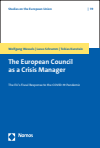Zusammenfassung
Faced with the deepest economic crisis in its history, the European Union established a seminal COVID-19 recovery package relying on common debt. This book analyses the European Council’s key role as a crisis manager and transformative force of the EU system. Combining thick descriptions of the history-making events of 2020-21 with EU theorising, we explain and critically assess the innovative set-up of the recovery package. Inside the European Council, we find a remarkable impetus for political consensus among national leaders. However, their detailed and ambiguous decisions at times came at the cost of political delay, legal uncertainty, and thin public scrutiny.
Angesichts der größten Wirtschaftskrise in ihrer Geschichte hat die Europäische Union ein COVID-19-Wiederaufbaupaket aufgelegt, das auf gemeinsamen Schulden beruht. Dieses Buch analysiert die Schlüsselrolle des Europäischen Rates als Krisenmanager und transformativer Kraft des EU-Systems. Durch eine umfassende Beschreibung der Ereignisse von 2020 und 2021 im Lichte von EU-Theorien bewerten die Autoren den innovativen Aufbau des Pakets. Im Europäischen Rat machen sie einen starken Impuls für politischen Konsens aus. Die detaillierten Entscheidungen der Regierungschefs erfolgten jedoch zuweilen um den Preis politischer Verzögerung, Rechtsunsicherheit und geringer parlamentarischer Kontrolle.
Abstract
Faced with the deepest economic crisis in its history, the European Union established a seminal COVID-19 recovery package relying on common debt. This book analyses the European Council’s key role as a crisis manager and transformative force of the EU system. Combining thick descriptions of the history-making events of 2020-21 with EU theorising, we explain and critically assess the innovative set-up of the recovery package. Inside the European Council, we find a remarkable impetus for political consensus among national leaders. However, their detailed and ambiguous decisions at times came at the cost of political delay, legal uncertainty, and thin public scrutiny.

